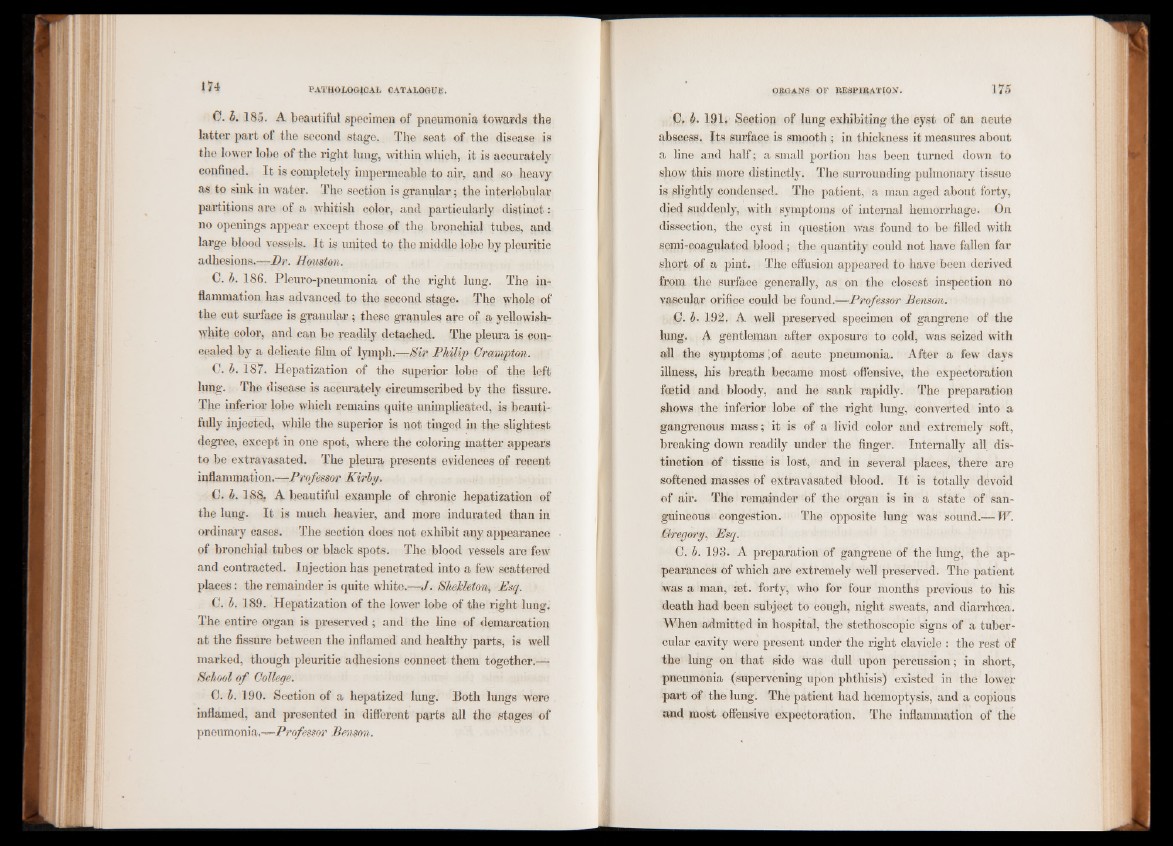
C. b. 185. A beautiful specimen of pneumonia towards the
latter part of the second stage. The seat of the disease is
the lower lobe of the right lung, within which, it is accurately
confined. It is completely impermeable to air, and so heavy
as to sink in water. The section is granular; the interlobular
partitions are of a whitish color, and particularly distinct:
no openings appear except those of the bronchial tubes, and
large blood vessels. It is united to the middle lobe by pleuritic
adhesions.—Dr. Houston.
0 . b. 186. Pleuro-pneumonia of the right lung. The inflammation
has advanced to the second stage, 'fhe whole of
the cut surface is granular; these granules aye of a yellowish-
white color, and can be readily detached. The pleura is concealed
by a delicate film of lymph.-—Sir Philip Crawpton.
0. b. 187. Hepatization of the superior lobe of the left
lung. The disease is accurately circumscribed by the fissure.
The inferior lobe which remains quite unimplicated, is beautifully
injected, while the superior is not tinged in the slightest
degree, except in one spot, where the coloring matter appears
to be extravasated. The pleura presents evidences of recent
inflammation.—Professor Kirby.
0. b. 188, A beautiful example of chronic hepatization of
the lung- It- is much heavier, and more indurated than in
ordinary cases. The section does not exhibit any appearance
of bronchial tubes or black spots. The blood vessels are few
and contracted. Injection has penetrated into a few scattered
places: the remainder is quite white.—J. SheJcleton, Esq.
C. b. 189. Hepatization of the lower lobe of the right lung.
The entire organ is preserved; and the fine of demarcation
at the fissure between the inflamed and healthy parts, is well
marked, though pleuritic adhesions connect them together.—
School of College.
0. b. 190. Section of a hepatized lung. Both lungs were
inflamed, and presented in different parts all the stages of
pneumonia,—Pro/^?.?or Benson.
0 . b. 191, Section of lung exhibiting the cyst of an acute
abscess, Jts surface is smooth; in thickness it measures about
a line and half; a small portion has been turned down to
show this more distinctly. The surrounding pulmonary tissue
is slightly condensed. The patient, a man aged about forty,
died suddenly, with symptoms of internal hemorrhage. On
dissection, the cyst in question was found to be filled with
semi-coagulated blood; the quantity could not have fallen far
short of a pint. The effusion appeared to have been derived
from the surface generally, as on the closest inspection no
vascular orifipe could be found.—Professor Benson.
C. b. 192. A well preserved specimen of gangrene of the
lung. A gentleman after exposure to cold, was seized with
all the symptoms 'of acute pneumonia. After a few days
illness, his breath became most offensive, the expectoration
foetid and bloody, and he sank rapidly. The preparation
shows the inferior lobe of the right lung, converted into a
gangrenous mass; it is of a livid color and extremely soft,
breaking down readily under the finger. Internally all distinction
of tissue is lost, and in several places, there are
softened masses of extravasated blood. It is totally devoid
of air. The remainder of the organ is in a state of sanguineous
congestion. The opposite lung was sound.— W.
Gregory, Esq.
0. b. 193. A preparation of gangrene of the lung, the appearances
of which are extremely well preserved. The patient
was a man, set. forty, who for four months previous to his
death had been subject to cough, night sweats, and diarrhoea.
When admitted in hospital, the stethoscopic signs of a tubercular
cavity were present under the right clavicle : the rest of
the lung on that side was dull upon percussion; in short,
pneumonia (supervening upon phthisis) existed in the lower
part of the lung. The patient had hoemoptysis, and a copious
and most offensive expectoration. The inflammation of the